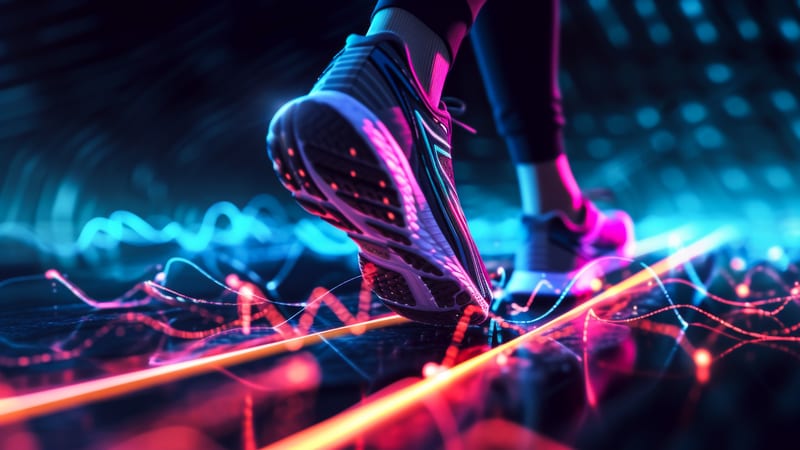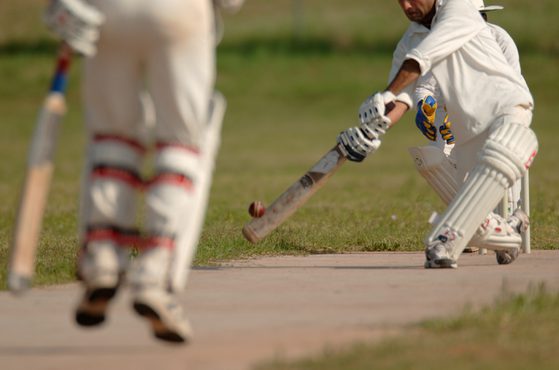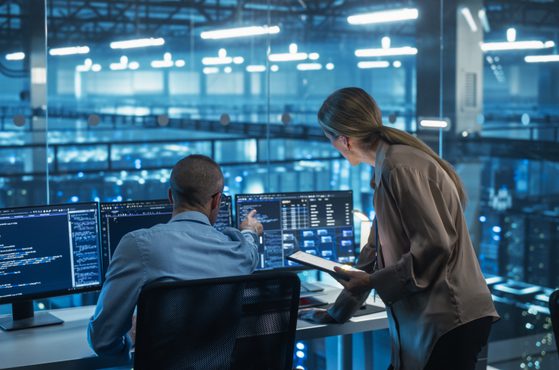From scouting, player valuations and performance analytics to personalised injury treatment and rehabilitation plans, technology and data are key to success for every sports organisation. AI is no longer seen as an experimental tool — it’s an integral strategic and performance enhancing tool.
With the UK’s AI market currently worth over £21bn and expected to grow to £1tn by 2035, Allana Edwards takes a look at how sports clubs are using technology in smart ways to impact results, wellbeing and revenue — from tactical modelling to scouting and recruitment. She also outlines the key legal and ethical considerations to ensure that new technologies are implemented securely and fairly.
Predicting game outcomes & modelling tactics
The world of elite sport is now shaped by performance science. AI allows coaches to capture, analyse and respond to vast datasets in real time at speeds that a human never could. These insights are then used to create tailored training plans, guide recovery and inform strategy.
In sports like cricket and basketball, AI is increasingly used to enhance tactical approaches by modelling opposition weaknesses and predicting game outcomes based on player statistics (such as event and tracking data) and environmental factors. Since weather and pitch conditions are known to be significant factors in cricket, AI can interpret weather forecasts and pitch reporting statistics into real-time assessments of how such conditions will affect a match. Such models learn over time, using historical data to relate their findings with the successes rates that teams achieve.
In football, wearable GPS tracking devices such as STATSports are helping to track positional data, acceleration, deceleration, sprint counts, heart rate variability and player load metrics. These data streams are then analysed to tailor individual training loads, reduce fatigue accumulation and improve match preparedness. Elite clubs like Manchester City and Liverpool FC are using AI-driven analysis of event and tracking data to assess opponent formations and predict counter-attacking patterns. Biometric analysis now informs in-game substitutions, based on fatigue modelling and the probability of performance dips.
Google DeepMind has collaborated with Liverpool FC to develop TacticAI — a system that’s specifically designed to optimise player positions at corner kicks. The latest model uses geometric deep learning on a data set comprising 7,176 corner kicks from the English Premier League between 2020 and 2023. This is just one example of how in-depth modern tactics have become, with teams looking for any slight advantage over their opponents that could make all the difference on matchday.
Training programmes, injury prevention & recovery
AI allows for the creation of hyper-personalised programmes that adapt in real time to an athlete's physiological and biomechanical data. By integrating inputs from GPS tracking, wearable sensors and video analytics, AI systems can monitor key indicators such as heart rate variability, neuromuscular fatigue and joint stress. This continuous monitoring allows for the dynamic adjustment of training loads, ensuring that athletes train at optimal intensities while minimising the risk of overtraining. AI can flag when an athlete enters the ‘danger zone’. Coaches and medical staff can then respond by reducing load or introducing recovery interventions to prevent an injury before one occurs.
In addition to injury prevention, AI plays a crucial role in managing return-to-play protocols post-injury. By comparing an athlete’s current biomechanics to their pre-injury baseline and peer benchmarks, AI systems provide objective assessments of recovery progress. This data-driven approach ensures that athletes regain full functionality safely and efficiently, reducing the likelihood of re-injury.
Furthermore, AI-powered models have been developed to predict post-concussion injury risks with remarkable accuracy. Researchers at the University of Delaware have created a machine learning model that predicts an athlete's risk of lower-extremity musculoskeletal injury after a concussion with 95% accuracy. This advancement allows for more informed decisions regarding an athlete's readiness to return to play, enhancing overall athlete safety.
Scouting & recruitment
Across various sporting disciplines, AI is also being used to reshape scouting and recruitment. AI systems are analysing thousands of hours of video and performance metrics to identify promising talents earlier on in their development. This is revolutionising the landscape of player acquisition and development, with the AI platform AiSCOUT even enabling football players to participate in virtual trials by performing athletic and technical drills that are then assessed by algorithms. This approach has facilitated the discovery of players who might have been overlooked by traditional scouting methods, with clubs like Burnley and Chelsea integrating AiSCOUT into their recruitment strategies.
AiSCOUT’s COO and director of sport science, Richard Felton-Thomas, said: “We help identify talent the scouts never knew existed. There are too many great young footballers slipping through the system. The technology helps target the right players faster, with data and insights to make better decisions and recruit down to Under-8 level based on whatever metrics a club is prioritising.”
Yet scouting isn’t just about finding talented players — it’s about finding people who align with a teams’ culture, mentality, playing style and long-term vision. The ideal recruit not only brings skill but also enhances the team as a whole, both on and off the pitch. To achieve this, top football clubs like Liverpool FC operate complex, AI-based scouting systems that combine extensive data analysis and psychometric assessments with machine learning. Liverpool’s use of spatial analysis to measure player adaptability within their pressing system allows them to recruit players that are suited to specific tactical demands.
AI in amateur & grassroots sport
While of course elite sport is leading on innovation, AI tools (like wearables and apps) are now trickling down to the amateur levels. Products like WHOOP use AI to interpret physiological data and provide tailored recovery and sleep advice to recreational athletes.
AI-driven platforms are also enabling more personalised coaching. For example, OnForm allows amateur athletes to receive AI-augmented video analysis, helping them to correct form and optimise performance. OnForm provides amateur athletes access to coaching and performance science, which historically has only been reserved for elite athletes.
As this technology becomes increasingly more affordable, we can only expect further uptake over the coming years and for wearables and coaching platforms to become commonplace in amateur sport.
AI & the law in elite sport
The advancement of AI brings with it big questions around ethics and legality, particularly in the world of sport. One of the most critical issues is data privacy. As biometric data is collected from athletes, there are concerns around consent and who actually owns this data, how it’s used and stored and if there’s potential for it to be misused. This is an especially critical issue when it comes to young and/or vulnerable athletes. Furthermore, athletes may not always be aware or informed about how their data is used. Sports organisations and AI developers need to ensure compliance with data protection laws and intellectual property ownership.
AI also raises questions around fairness if certain teams can afford more advanced AI systems that provide advantages over others. This is especially true when computer vision systems — coupled with machine learning algorithms — assist human judges in sports that require precise measurements or subjective scoring. Any lack of universal access to systems used in the judgement and scoring of sports presents issues of unfair competition.
Furthermore, the use of AI for refereeing and decision-making during competitions must be transparent to ensure fairness and presents significant regulatory challenges. Athletes and teams may challenge the legitimacy of AI-assisted decisions if they believe that the technology is flawed or biased, potentially leading to disputes and appeals under existing sports resolution frameworks.
An overreliance on AI for injury prediction and treatment may also bring inherent legal complexities. Liability is questionable when AI — rather than clinical judgement — is being used to make decisions that turn out to have a negative impact on an athlete’s health. It remains unclear whether such legal responsibility lies with a club, its medical staff or AI developers. These questions highlight the need for new regulatory frameworks and legal clarity.
Transparency, accountability and consent should be core principles in any AI deployment. As sport regulators work to catch up, sports lawyers can play a crucial role when navigating tensions between innovation and regulation and the successful introduction of AI into the sports regulatory, governance and commercial framework.
Talk to us
Our specialist and multi-award-winning sports law team is recognised nationally and internationally as one of the largest and most experienced multidisciplinary legal teams in the industry.
With expert sports tech advisors, we guide the world of sport through the complex issues involved in the use of technology.
Our mandates include:
- Assisting with correct governance and best practice.
- Enhancing commercial growth.
- Event organisation.
- Stewardship of membership and fan data.
- Providing legal advice on investments and corporate transactions in the world of sport.
We work closely with national governing bodies, international federations, elite sports clubs, large sports agencies, investors, technology providers and elite sportspeople both nationally and globally.
Talk to us by calling 0333 004 4488, emailing hello@brabners.com or completing our contact form below.




